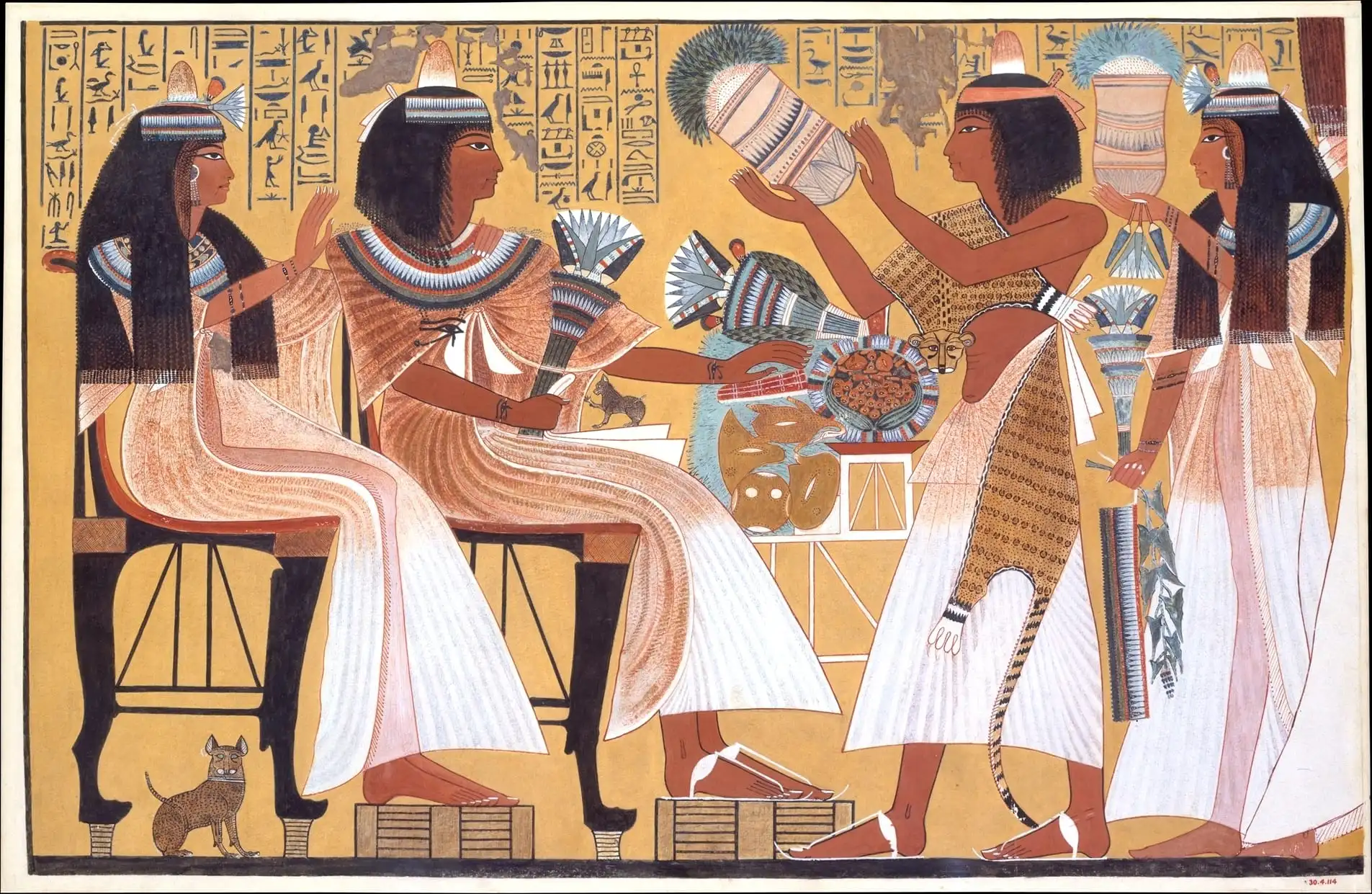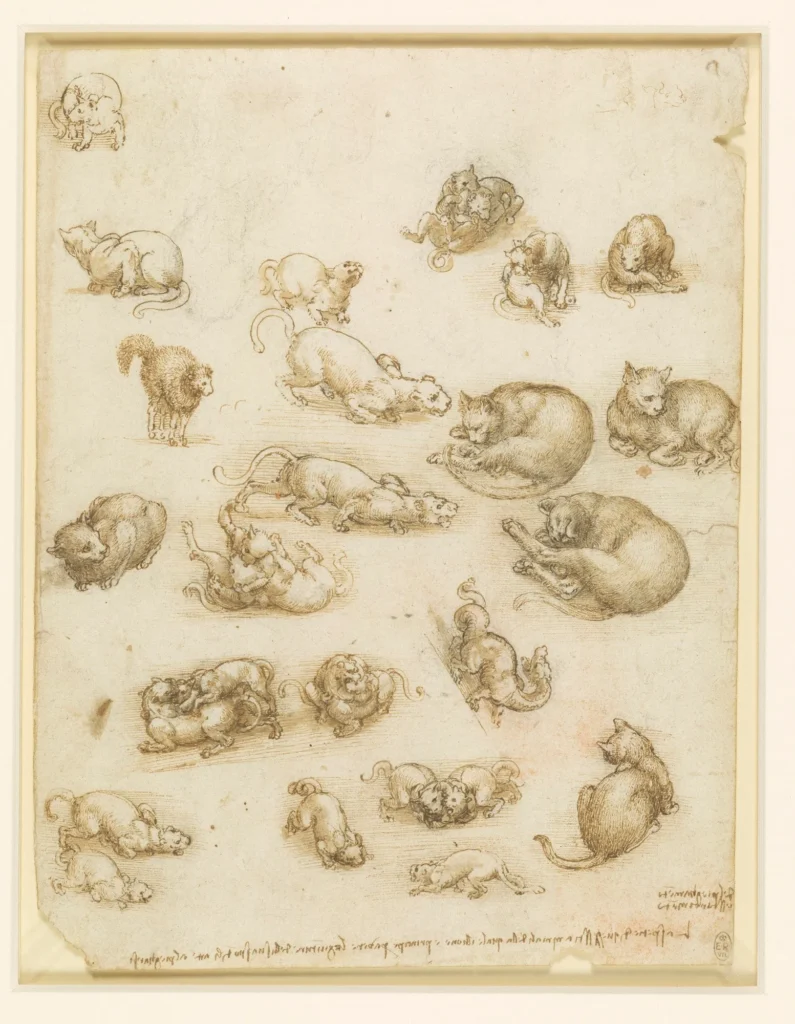Table of Contents
Cats in art have long served as muse and motif, weaving their way through the tapestry of human creativity with grace and mystery. From the sacred depictions of ancient Egypt to the avant-garde experiments of modern artists, felines have left an indelible mark on our cultural imagination. In this exploration of “cats in art”, we delve deep into the symbolic significance, historical context, and enduring influence of these enigmatic creatures. Through the annals of history and the corridors of literature, cats emerge as more than just subjects—they are symbols of independence, guardianship, and the timeless allure of the unknown. Join us as we unravel the threads of creativity woven by the pawprints of these captivating creatures.

This image shows a wall painting from the tomb of Ipuy, at Deir el-Medina. Ipuy has a small kitten sitting on his lap whilst a cat sits under his wife’s chair
Ancient Egyptian Depictions
In ancient Egypt, cats held a sacred status and were revered as manifestations of the goddess Bastet, who represented home, fertility, and domesticity. Bastet was often depicted with the head of a lioness or as a domestic cat. These depictions of cats in art symbolized protection, fertility, and the cycle of life and death. Cats were not only beloved companions but also guardians against evil spirits, a belief that led to their frequent inclusion in tomb paintings and amulets.

Leonardo da Vinci – Cats, lions, and a dragon, 1517-18 ©
Cats in Renaissance Art
During the Renaissance, cats continued to play a prominent role in art, albeit with evolving symbolism. Artists like Leonardo da Vinci and Albrecht Dürer incorporated cats into their works, often portraying them as symbols of domesticity and femininity. Cats were depicted lounging in the background of domestic scenes or nestled in the laps of their human companions. These paintings reflected the growing emphasis on domestic life and the importance of pets as cherished members of the household.

Picasso – Cat Catching a Bird, 1939 ©
Cats in Modern Art
In the modern era, cats in art have been reimagined in various artistic movements, from Impressionism to Surrealism and beyond. Artists like Édouard Manet and Pablo Picasso experimented with depicting cats in their works, exploring themes of curiosity, mystery, and the subconscious mind. One notable example is Picasso’s “Cat Catching a Bird,” which captures the feline’s predatory instinct in a cubist composition. Cats have also found their place in contemporary art, with artists like Jeff Koons and Banksy incorporating them into their installations and street art.
Symbolic Meanings
Independence and Mystery
Cats in art and literature, have long been associated with independence and mystery. Their solitary nature and enigmatic behavior make them compelling subjects for artists seeking to convey themes of self-reliance and introspection. Whether lounging in shafts of sunlight or prowling through moonlit streets, cats embody a sense of quiet confidence and autonomy that resonates with viewers on a deep emotional level.
Guardianship and Protection
In addition to their symbolic association with independence, cats have also been revered as guardians and protectors in various cultures. In ancient Egypt, they were believed to safeguard households and bring good fortune to their owners. This protective symbolism is echoed in contemporary art, where cats are often depicted as vigilant sentinels watching over their human companions with unwavering loyalty and devotion.
Influence on Literature
Cats have left an indelible mark on literature, inspiring writers to explore themes of magic, mystery, and the supernatural. From Edgar Allan Poe’s eerie tale “The Black Cat” to Haruki Murakami’s surreal novel “Kafka on the Shore,” cats have appeared in countless stories, poems, and novels, serving as symbols of intuition, wisdom, and otherworldly insight. Their enigmatic presence adds depth and complexity to literary works, inviting readers to ponder the mysteries of the universe alongside these enigmatic felines.
Notable Examples
- “The Cat in the Hat” by Dr. Seuss: This beloved children’s book features a mischievous cat who brings chaos and fun into the lives of two siblings on a rainy day.
- “Old Possum’s Book of Practical Cats” by T.S. Eliot: This collection of whimsical poems delves into the secret lives of cats, each poem portraying a different feline personality.
- “Puss in Boots”: A classic fairy tale featuring a clever cat who helps his master gain wealth and power through cunning tricks and deceit.
Continue Learning
In conclusion, exploring the profound influence of cats in art and literature unveils a rich tapestry of creativity woven with whiskered wonders. As we delve deeper into the enigmatic presence of felines in human culture, it becomes evident that their impact transcends time and medium.
To further explore the intricate relationship between animals and creativity, venture into our posts on birds and dogs categories, where you’ll discover equally fascinating tales of inspiration and companionship. For a more focused exploration of our feline friends, browse through our dedicated category on cats, where each article delves into different facets of cats’ influence on our lives. Join us on this captivating journey through the animal kingdom, where every creature holds a story waiting to be uncovered.
F. A. Q. about Cats in Art
What do cats represent in art?
Cats in art symbolize a myriad of themes, including independence, mystery, feminity, domesticity, and guardianship. They are often portrayed as enigmatic creatures embodying grace, elegance, and autonomy.
Why are cats frequently shown in ancient Egyptian art?
In ancient Egypt, cats were revered as sacred animals associated with the goddess Bastet. They symbolized protection, fertility, and the cycle of life and death, making them popular subjects in art and religious iconography.
Which artists draw pictures of cats?
Numerous artists throughout history have depicted cats in their works, including Leonardo da Vinci, Édouard Manet, Pablo Picasso, and contemporary artists like Jeff Koons and Banksy.
What symbolic meanings do cats hold in art?
Cats symbolize traits such as independence, mystery, guardianship, and protection in art. They serve as potent symbols of self-reliance, intuition, and the connection between the mundane and the supernatural.
How have cats influenced the art?
Cats have profoundly influenced art across different periods and movements, inspiring artists to explore themes of beauty, mystery, and the human-animal bond. Their enduring presence continues to captivate audiences and inspire creativity across various artistic mediums.


